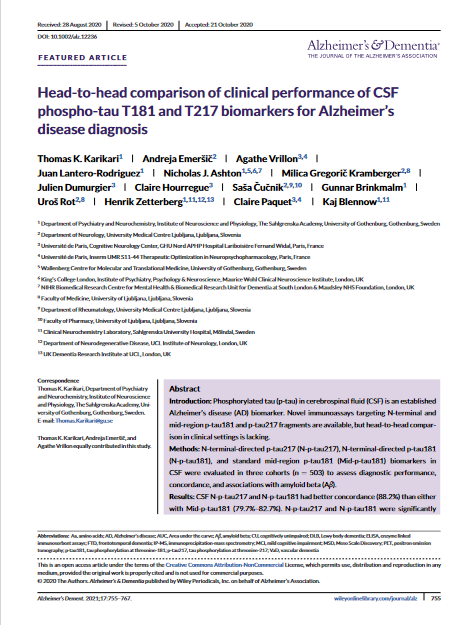10.09.2021
Head-to-head comparison of clinical performance of CSF phospho-tau T181 and T217 biomarkers for Alzheimer's disease diagnosis
Alzheimer's & Dementia : the Journal of the Alzheimer's Association, 2020
Abstract
Introduction
Phosphorylated tau (p-tau) in cerebrospinal fluid (CSF) is an established Alzheimer's disease (AD) biomarker. Novel immunoassays targeting N-terminal and mid-region p-tau181 and p-tau217 fragments are available, but head-to-head comparison in clinical settings is lacking.
Methods
N-terminal-directed p-tau217 (N-p-tau217), N-terminal-directed p-tau181 (N-p-tau181), and standard mid-region p-tau181 (Mid-p-tau181) biomarkers in CSF were evaluated in three cohorts (n = 503) to assess diagnostic performance, concordance, and associations with amyloid beta (Aβ).
Results
CSF N-p-tau217 and N-p-tau181 had better concordance (88.2%) than either with Mid-p-tau181 (79.7%-82.7%). N-p-tau217 and N-p-tau181 were significantly increased in early mild cognitive impairment (MCI)-AD (A+T-N-) without changes in Mid-p-tau181 until AD-dementia. N-p-tau217 and N-p-tau181 identified Aβ pathophysiology (area under the curve [AUC] = 94.8%-97.1%) and distinguished MCI-AD from non-AD MCI (AUC = 82.6%-90.5%) signficantly better than Mid-p-tau181 (AUC = 91.2% and 70.6%, respectively). P-tau biomarkers equally differentiated AD from non-AD dementia (AUC = 99.1%-99.8%).
Discussion
N-p-tau217 and N-p-tau181 could improve diagnostic accuracy in prodromal-AD and clinical trial recruitment as both identify Aβ pathophysiology and differentiate early MCI-AD better than Mid-p-tau181.
Tau-441, GSK3beta-phosphorylated, Human manufactured by our partner SignalChem is featured in this study.


